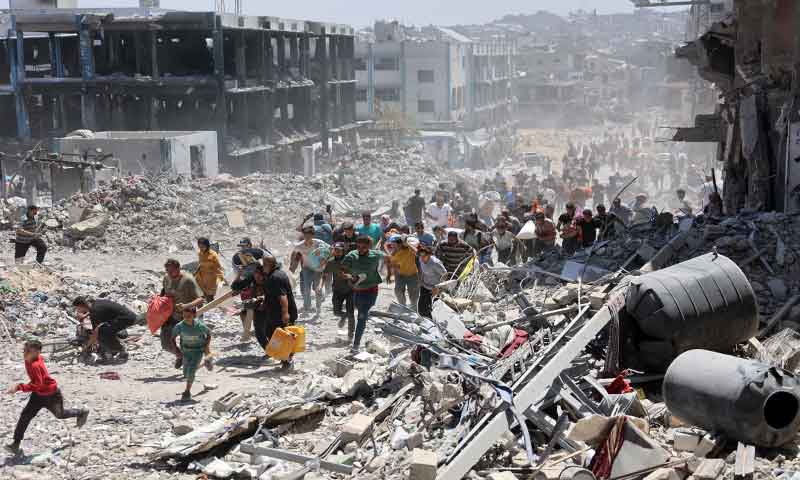
The data has been compiled by the American Enterprise Institute’s Critical Threats Project, the Institute for the Study of War and CNN.
Israeli Prime Minister Benjamin Netanyahu, who faces growing international pressure to agree to a ceasefire and hostage release deal in Gaza, has repeatedly said that Israeli forces are nearing their stated goal of eliminating Hamas and destroying its military capabilities. Addressing a joint meeting of Congress on July 24, he said: “Victory is in sight.”
However, forensic analyses of Hamas’ military operations since it led attacks against Israel on October 7, which draw on Israeli and Hamas military statements, footage from the ground and interviews with experts and eyewitnesses, cast doubt on his claims.
Also read: US tells G7 Iran and Hezbollah attack on Israel imminent
Israel has dealt a heavy blow to the militant group: senior Hamas figures have been killed and the ongoing offensive has reduced what once was a professional fighting force into a guerrilla army.
Hamas’ political leader, Ismail Haniyeh, was assassinated last week in Tehran in an attack Iran has blamed on Israel. Israel has not claimed responsibility, but said a day later that Hamas’ top military commander, Mohammad Deif, was killed in a July 13 airstrike in Gaza — a report Hamas has neither confirmed nor denied.
And yet, the research, which covers Hamas’ activities up until July, shows that the group appears to have made effective use of dwindling resources on the ground. Several units have made a comeback in key areas cleared by the Israeli military after pitched battles and intensive bombardment, according to the new analyses, salvaging the remnants of their battalions in a desperate bid to replenish their ranks.
Also read: Bangladesh PM Hasina lands in India as army takes over
“The Israelis would say that they cleared a place, but they haven’t fully cleared these areas, they haven’t defeated these fighters at all,” said Brian Carter, Middle East portfolio manager for Critical Threats Project (CTP), who led the joint research with the Institute for the Study of War (ISW) into patterns of Hamas and Israeli military activity.
“(Hamas) are ready to fight and want to fight.”
The forensic analyses in this report use definitions from the US military to characterize the status of Hamas units, which differ from Israeli military definitions.
The Israeli Prime Minister’s Office has not responded to CNN’s requests for comment on the report.
CTP-ISW derive these definitions from US military definitions which are different from Israeli military definitions.
Hamas’ military wing, known as the Qassam Brigades, is divided into 24 battalions spread throughout the territory, according to the Israeli military.
As of July 1, only three of these 24 battalions were combat ineffective, meaning they were destroyed by the Israeli military, according to the assessments by CTP and ISW.
A unit is combat ineffective when it is no longer able to complete its mission. This is frequently represented by no attacks or very few ineffective attacks.
Eight battalions are combat effective, able to carry out missions against Israeli soldiers on the ground in Gaza.
A combat effective unit can accomplish the mission that it is assigned. CTP and ISW rated units combat effective when they assessed that they were defending ground using sophisticated tactics and more advanced weapon systems.
The remaining 13 have been degraded, only able to conduct sporadic, and largely unsuccessful guerrilla-style attacks.
A degraded unit has had losses that impede its ability to execute assigned missions, and it only shows some of the characteristics of a combat effective unit. It may have lost several commanders in a short time period and Israeli military reports could refer to it as “dismantled.”
The battalions in central Gaza are the least damaged in the strip, according to Israeli military sources and the analyses. Israeli sources say they have not adequately “dealt” with those battalions because they are believed to be holding many Israeli hostages.
CTP, ISW and CNN’s analyses of Hamas’ ability to reconstitute focused on 16 battalions in central and northern Gaza, the longest-running targets of the Israeli offensive.
Reconstitution is a set of actions that aim to restore an acceptable level of combat effectiveness for a particular mission after severe degradation. Reconstitution consists of two tasks: regeneration and reorganization.
Seven of these 16 battalions have been able to reconstitute – rebuild some of their military capabilities at least once in the last six months. All of these are in the battered north of the strip.
The analyses published in this CNN report excluded southern Gaza because of incomplete historical data on the status of the eight Hamas battalions believed to be operating there.
CNN combed through thousands of claims by the Qassam Brigades and the Israeli military, and geolocated scores of videos showing battles in Gaza in recent months, to verify and analyze the findings by the DC-based think tanks.
Interviews with Israeli military and Palestinian civilian sources on the ground in Gaza also helped corroborate trends shown in their research.
US military experts interviewed for this report said that Israel s prosecution of the war, defined by a heavy-handed bombing campaign, and the absence of a post-war plan has helped trigger Hamas resurgence. (The views expressed in interviews included in this report do not necessarily reflect those of CTP and ISW).
There has been evidence of that resurgence in key flashpoints. In Jabalya refugee camp, Israel said it returned in May to “fierce” resistance from three Hamas battalions, despite having devastated the area in a nearly three-month bombing campaign in the fall. And Israel has staged four incursions in Gaza City’s Zeitoun neighborhood, according to the analyses.
Satellite imagery shows the extent of the destruction in Jabalya refugee camp, in northern Gaza, over the first nine months of the war. Planet Labs PBC
“If the Hamas battalions were largely destroyed, Israeli forces wouldn’t still be fighting,” said retired US Army Col. Peter Mansoor, who helped oversee the deployment of an additional 30,000 US troops to Iraq in 2007 – a counterinsurgency strategy known as “the surge.”
Mansoor served as executive officer to retired Gen. David Petraeus, the head of US-led multinational forces at the time.
“The fact that they’re still in Gaza, still trying to rout out elements of the Hamas battalions shows me that Prime Minister Netanyahu is wrong,” he added. “The ability of Hamas to reconstitute its fighting forces is undiminished.”
US military experts have repeatedly cited the surge as an effective blueprint for Israel. Its architect, Petraeus, advised Israel in an article in Foreign Affairs to “sharply distinguish” Hamas from civilians to “prevent irreconcilable Hamas elements from reconstituting.” He also called on Israel to support an alternative government in Gaza.




